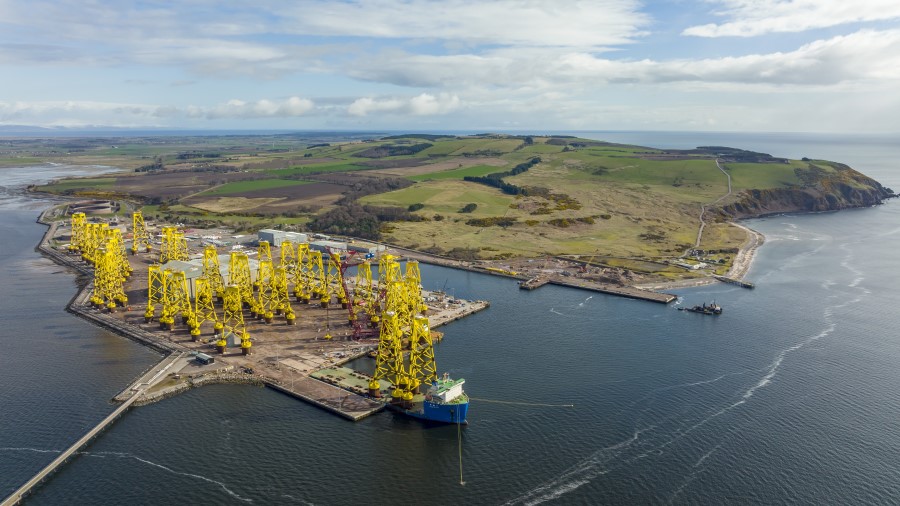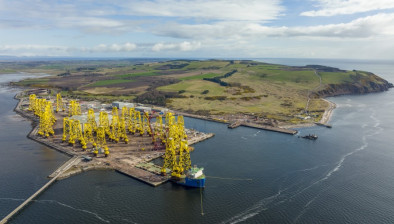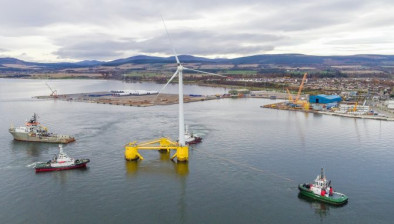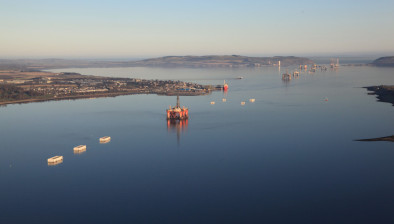Cromarty Firth and the Forth chosen as Scotland’s green freeports

Port of Nigg on the Cromarty Firth (Picture credit: ROAVR Group)
Cromarty Firth and the Forth have been jointly selected by the Scottish and UK governments to become Scotland’s first “green freeports”.
The winning bids by Opportunity Cromarty Firth (OCF) and Forth Green Freeport (FGF) will be supported by up to £52 million in start-up funding and will benefit from tax reliefs and other incentives through a combination of devolved and reserved powers.
Applicants to become a green freeport in Scotland were required to demonstrate how they would contribute towards a just transition to net zero emissions by 2045 and create new, green jobs. They were also required to set out how they would support high-quality employment opportunities with fair work conditions at their core.
Deputy First Minister John Swinney said today’s announcement represented a “milestone achievement in the process to deliver green freeports for Scotland”.
“Scotland has a rich history of innovation, trade and manufacturing and as we look to seize the many opportunities achieving net zero offers, the creation of these internationally competitive clusters of excellence will help us to create new green jobs, deliver a just transition and support our economic transformation,” he added.
Levelling Up Secretary Michael Gove said: “Inverness and Cromarty Firth and the Firth of Forth are fantastic areas for these new green freeports to set up, ensuring the benefits are felt right across Scotland. This will help to create exciting new jobs, boost business and encourage investment in the local areas and beyond.”
The private-public bid consortium behind the Forth Green Freeport bid said its proposal will create up to 50,000 new green jobs, unlock £6 billion of private and public investment and generate a £4bn boost in GVA to Scotland’s economy.
The consortium includes Forth Ports, Babcock, INEOS, Edinburgh Airport, Scarborough Muir Group, Falkirk Council, Fife Council and the City of Edinburgh Council.
Charles Hammond OBE, chief executive of Forth Ports and lead FGF bid partner with sites at Leith, Grangemouth, Rosyth and Burntisland, said: “Today’s shortlisting is great news for Scotland, for new green jobs and for the country’s drive to net zero.
“Together with our consortium partners, our bid will re-industrialise the nation and create large scale economic development. Our green freeport will accelerate investment and generate 50,000 new green jobs by acting as a catalyst for new technologies and renewable energy manufacturing.
This has the potential to unlock £6bn of private and public investment for Scotland and create new training facilities, factories, logistics parks, rail, freight and fuel terminals and to enhance our creative industries.
“The benefits of trade will be spread widely into the communities that need it the most, through the establishment of a green growth investment corridor creating tens of thousands of jobs in low carbon logistics, renewable energy, green manufacturing and alternative fuels.
“These new jobs will not just be in Grangemouth, Leith and Rosyth, but in Glasgow and Edinburgh; the Lothians, Stirling and Falkirk; Dunfermline and Burntisland; and across the UK.”
The OCF consortium, launched in 2020, includes the ports of Cromarty Firth, Nigg and Inverness and also the Highlands’ largest air terminal and Inverness Airport Business Park.
Stuart Black, chief executive of Highlands and Islands Enterprise (HIE), congratulated OCF on the successful bid and said it was “fantastic news” for the region.
He said: “The Highlands and Islands will play a critical role in meeting the challenging net zero targets at both Scotland and UK levels. Green freeport status for the Cromarty Firth will be a huge asset, driving collaboration between industry, academia and the public sector to stimulate transformational regeneration through economic activity, investment, innovation and skills development.
“It will attract large-scale manufacturing and create thousands of green jobs that complement the skills of the local workforce and accelerate Scotland’s and the UK’s progress to achieving net zero targets”
Tracy Black, director of CBI Scotland, said: “Congratulations to the Firth of Forth and the Inverness and Cromarty Firth for becoming Scotland’s first green freeport sites.
“With this significant first step now taken, businesses must work closely with government at all levels to ensure that the two areas – and Scotland as a whole – benefit from the new economic opportunities as quickly as possible.
“With Scotland’s economy continuing to experience challenging headwinds, this announcement shows the value of having the UK and Scottish governments pull in the same direction to promote growth and recovery.”
Commenting on the successful Scottish green freeport bids, Sheelagh Cooley, real estate partner at Shoosmiths, said: “The confirmation of two green freeports in Inverness and Cromarty Firth and the Forth represents an opportunity to drive forward new development, regeneration and economic growth in Scotland.
“The potential impact of these projects, however, must not be limited to the immediate vicinity of the green freeports. Rather, true success hinges on the ability to also revitalise surrounding towns and cities, many of which are economically deprived.
“In Inverness and Cromarty Firth, the introduction of a green freeport is said to have the potential to unlock £2.5bn of new private sector investment – creating up to 25,000 jobs. This is alongside developing wind power technology, with its port facilities already supporting offshore wind projects.
“While the introduction of green freeports is governed by UK legislation, the model’s legislative structure is subject to devolved and reserved powers. The sites are intended to be secure custom zones where business can be carried out inside a land border, but where different custom and tax rules apply - offering various regulatory and financial incentives.
“From a planning perspective, the green freeports are likely to operate under extended permitted development rights. Combined with a streamlining of the consenting process for development, this type of relaxed planning regime could, in theory, allow schemes – residential, commercial and infrastructure - to be brought forward at speed and avoiding certain barriers.
“Unlike the UK government’s freeport model, and investment zone proposals, Scottish green freeports are subject to additional requirements, including on carbon neutrality and paying the real Living Wage.
“The Forth green freeport could act as a catalyst for the manufacture of offshore wind turbines, shipbuilding and energy systems. It encompasses several ports, industrial and logistics sites, as well as Edinburgh Airport, with the consortium behind the bid outlining that it could lead to a boom in job creation and economic growth that is rooted in renewable energy and decarbonisation.
“The successful bidders will now work with the Scottish and UK Government to determine a governance structure for each site. A process that must balance deregulation and economic growth with protecting the environment and assisting the transition to net zero.
“Subject to compliance with the regulatory controls, green freeports should provide a welcome opportunity for growth in the Scottish economy, especially in the energy, infrastructure and manufacturing sectors.”






















